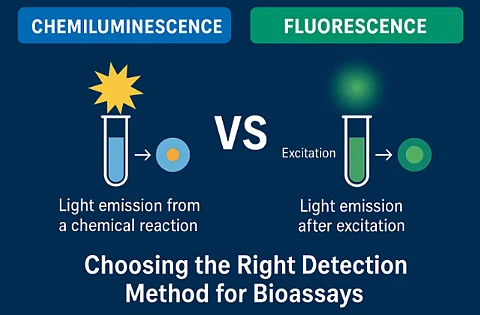Technology
Fluorescence and Chemiluminescence: Choosing Your Detection Strategy

The choice between fluorescence and chemiluminescence detection strategies is crucial for researchers involved in bioanalytics. These methodologies significantly impact the sensitivity, accuracy, and reproducibility of experimental results. As artificial intelligence (AI) continues to transform diagnostics and data-driven life sciences, understanding the distinctions between these two techniques becomes essential for enhancing assay performance and data quality.
Fluorescence Detection: Overview and Considerations
Fluorescence detection operates on the principle of photoluminescence. In this method, specific molecules absorb light at one wavelength and re-emit it at a longer wavelength. A common application involves a fluorophore-labeled probe binding to a target molecule. When excited by a specific wavelength, the fluorophore emits light that can be quantified by a detector.
The advantages of fluorescence detection include high sensitivity, capable of identifying low-abundance targets when optimized. It also offers multiplexing capabilities, allowing multiple fluorophores with distinct emission spectra to be utilized simultaneously. Additionally, real-time monitoring is possible, with kinetic measurements enhanced by AI-driven image analysis software.
However, this method is not without limitations. Background noise from autofluorescence in biological samples, as well as non-specific binding, can diminish signal quality. Photobleaching is another concern, as fluorophores may degrade under prolonged excitation, leading to reduced signals. Furthermore, the need for complex instrumentation, including precise excitation and emission filters, can complicate the process. Fluorescence is commonly employed in applications such as flow cytometry, quantitative PCR (qPCR), and high-content screening, where its capabilities are particularly advantageous.
Chemiluminescence Detection: Principles and Applications
In contrast to fluorescence, chemiluminescence does not require external light excitation. Instead, light emission results from a chemical reaction, commonly involving enzyme-catalyzed oxidation of a substrate. A prominent example is the horseradish peroxidase (HRP)-luminol system used in Western blotting.
Chemiluminescence offers exceptional sensitivity, as the absence of excitation light minimizes background noise, enabling the detection of targets at femtogram levels. The high signal-to-noise ratio leads to clearer data, and since the signal is generated chemically, photobleaching is not a concern. This technique is particularly valuable in applications requiring maximum sensitivity, such as ELISA and low-abundance biomarker detection.
Nevertheless, chemiluminescence has its drawbacks. Limited multiplexing capabilities arise due to overlapping emission spectra, making simultaneous detection of multiple targets challenging. Additionally, chemiluminescent reactions can decay rapidly, necessitating precise timing for optimal signal measurement. Furthermore, this method is often unsuitable for real-time kinetic studies, although advancements in time-resolved AI analysis are beginning to address these limitations.
Factors to Consider When Choosing a Detection Method
Selecting the appropriate detection method depends on various experimental parameters. If ultimate sensitivity is paramount, particularly in detecting small amounts of proteins, chemiluminescence typically outperforms fluorescence due to its low background nature. Nonetheless, fluorescence can achieve high sensitivity through optimized probe design and signal amplification, especially when integrated with AI tools for analysis.
Fluorescence is generally preferred for multiplex assays, where different fluorophores can be detected by their unique emission spectra. In contrast, chemiluminescence emits light at a single wavelength, limiting its effectiveness in multi-target assays. Fluorescent signals tend to be stable, allowing for continuous monitoring and kinetic measurements. Conversely, chemiluminescent signals, while often bright, are short-lived and require precise timing to capture peak emissions.
Instrumentation also plays a critical role in these methodologies. Fluorescence assays necessitate excitation sources, emission filters, and detectors capable of distinguishing between overlapping spectra. Chemiluminescence requires highly sensitive photon-detection instruments to capture the weak and transient signals. Major manufacturers, such as Berthold, have developed high-performance luminometers designed for advanced bioanalytical applications, ensuring that researchers achieve the necessary sensitivity.
In conclusion, both fluorescence and chemiluminescence are powerful detection techniques, each with distinct advantages suited to specific applications. Fluorescence is ideal for multiplexing and kinetic measurements, while chemiluminescence excels in sensitivity and low-background detection. Ultimately, the choice depends on the experimental goals, available instrumentation, and the desired quality of data output. As AI continues to advance, researchers can anticipate improved precision and efficiency from both of these methodologies in the field of bioanalytics.
-

 Technology4 months ago
Technology4 months agoDiscover the Top 10 Calorie Counting Apps of 2025
-

 Health2 months ago
Health2 months agoBella Hadid Shares Health Update After Treatment for Lyme Disease
-

 Health3 months ago
Health3 months agoErin Bates Shares Recovery Update Following Sepsis Complications
-

 Technology3 weeks ago
Technology3 weeks agoDiscover 2025’s Top GPUs for Exceptional 4K Gaming Performance
-

 Technology2 months ago
Technology2 months agoElectric Moto Influencer Surronster Arrested in Tijuana
-

 Technology4 months ago
Technology4 months agoDiscover How to Reverse Image Search Using ChatGPT Effortlessly
-

 Technology4 months ago
Technology4 months agoMeta Initiates $60B AI Data Center Expansion, Starting in Ohio
-

 Technology4 months ago
Technology4 months agoRecovering a Suspended TikTok Account: A Step-by-Step Guide
-

 Health4 months ago
Health4 months agoTested: Rab Firewall Mountain Jacket Survives Harsh Conditions
-

 Lifestyle4 months ago
Lifestyle4 months agoBelton Family Reunites After Daughter Survives Hill Country Floods
-

 Technology3 months ago
Technology3 months agoUncovering the Top Five Most Challenging Motorcycles to Ride
-

 Technology4 weeks ago
Technology4 weeks agoDiscover the Best Wireless Earbuds for Every Lifestyle




















